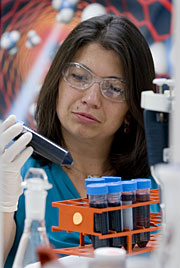- Number 300 |
- November 23, 2009
Carbon nanotube technology goes commercial

Olgica Bakajin licensed carbon
nanotube technology that she
helped create
while at LLNL.
DOE's Lawrence Livermore National Laboratory has exclusively licensed to Porifera Inc. of Hayward a carbon nanotube technology that can be used to desalinate water and can be applied to other liquid-based separations.
Carbon nanotubes—special molecules made of carbon atoms in a unique arrangement—allow liquids and gases to rapidly flow, while the tiny pore size can block larger molecules, offering a cheaper way to remove salt from water.
“The technology is very exciting,” said Olgica Bakajin, who serves as chief technology officer of Porifera and is one of the LLNL researchers who created the carbon nanotubes. “It’s at the right place to take it to the marketplace.”
Bakajin formerly worked at LLNL where she was recruited in 2000 as a Lawrence Fellow, then moved on to become chief scientist on the carbon nanotube project along with LLNL chemist Aleksandr Noy, another former Lawrence Fellow. Bakajin is currently on a two-year entrepreneurial leave from the Laboratory. The license was awarded through LLNL’s Industrial Partnership Office.
Porifera is developing membranes with vastly superior permeability, durability and selectivity for water purification and other applications in the clean tech sector such as carbon dioxide sequestration. The technology is based on discoveries at LLNL.
The technology first took off when it was funded by Livermore’s Laboratory Directed Research and Development Program and supported by the Science and Technology Principal Directorate. Recently, Bakajin, Noy and another LLNL scientist, Francesco Fornasiero, and Porifera scientists Sangil Kim and Jennifer Klare, thought about different applications for the nanotube membranes.
“Carbon sequestration has always been at the back of our minds, as unique properties of carbon nanotube membranes provide critical advantages for potential use in carbon sequestration applications,” Noy said. Bakajin added the membranes would separate carbon dioxide from nitrogen in power plant emissions. The membranes would transfer the two gases at a different rate so that the CO2 could be separated and sequestered. Sequestering C02 is a key strategy to help curb global warming.
“We’ve known about the possibilities for this for quite some time,” Bakajin said. “The reason it makes sense to do it is because of the unique nanofluidic properties of carbon nanotube pores. We believe that our approach will work and we’re looking forward to working with the Lab on this.”[Anne Stark, 925.422.9799,
stark8@llnl.gov]
